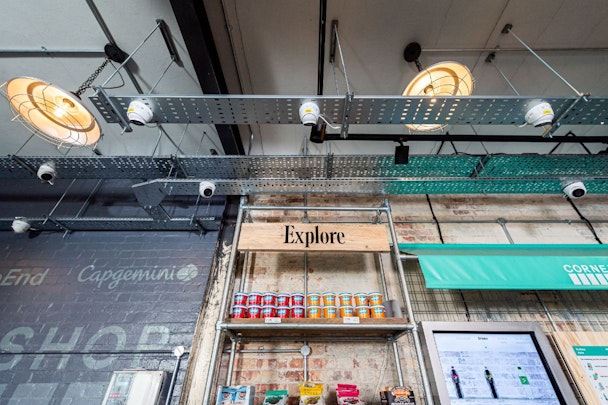How grocery retailers are successfully merging bricks and clicks
As part of our ‘Behind the future of retail’ content series, we look at how the grocery industry is shifting retail strategies to meet the needs of customers where they want to shop.

More than half of consumers now expect seamless omnichannel experiences in digital and physical spaces
Grocery retailing is constantly changing and Covid-19 has accelerated this change by completely transforming the way that people shop for groceries. At the height of the pandemic, grocery retailers struggled to cope with the surge in online delivery orders as shoppers determinedly waited in online queues for hours, sometimes staying up late into the night in the hopes of securing a slot.
While the surge in online shopping has since eased in line with the government’s stay-at-home guidance, there is significant evidence that our online shopping habits have stuck. Research by Kantar shows that 12.6% of grocery sales were carried out online in March 2022, up from 8% three years ago. This shift has required grocery retailers to adapt rapidly.
The shift from bricks to clicks
According to research by Frog, part of Capgemini Invent, 54% of consumers now expect seamless omnichannel experiences in digital and physical spaces. There have been a number of drivers behind this – the pandemic dramatically increased sales through digital channels, particularly among new or previously low-level digital shoppers. As a consequence, when stores reopened, their expectations of friction-free shopping across all channels were extremely high, with the anticipation that there would be complete consistency between the store and digital experience.
This means that retailers need to invest in technologies that enable the customer to engage directly, either via app, social or the website, but with the store still playing a key role.
Advertisement
“The market is by no means saturated; research from Spryker indicates that 80% of UK consumers would buy more groceries online if the overall experience improved,” says Steve Hewett, vice-president and customer transformation and CX tech leader at Frog. “This illustrates the size of the prize for whoever can get it right.”
Grocery shopping in particular is increasingly involving a combination of online and offline purchasing, according to eFoodInsights’ Online Grocery Report 2022. Supermarkets that have prioritized the roll-out of online ordering have been rewarded with high rates of brand recognition.
When consumers were asked to name online grocery delivery services, 70% of the most frequently named providers were established in-store retailers. 43.1% of respondents named Tesco, 34.5% Asda, 24% Sainsbury’s and 20.5% Morrisons. Meanwhile, only 25.6% of respondents named Ocado – the original online-only supermarket.
Advertisement
Successful omnichannel strategies
Tesco dominates the UK grocery retail market, with a market share of 27.2%. Tesco.com, which was initially created to provide customers with a complimentary experience to their in-store shop, is currently the third most visited grocery store worldwide. There are several key reasons why Tesco continues to dominate the market:
It connects its online and physical platforms: availability has always been at the center of Tesco’s priorities. When the brand first set up its online branch, it began with a simple fulfillment model of in-store picking. This allowed pickers to report on out-of-stock items, which helped stores to resupply faster from the central warehouse and fed into the success of a physical model.
It offers personalized experiences to customers: over 20 million British households have a Tesco Clubcard, which enables the brand to collect data on shopper behavior online and offline to provide a smoother shopping experience and more relevant recommendations.
It promotes convenience and reduces barriers: shoppers who typically shop in-store can use their Tesco Clubcard online to populate their shopping basket with items they would typically buy in a supermarket. This removes a significant amount of frustration for shoppers who are overwhelmed with the number of choices they have online and makes it easier to find the items they need.
It understands its customers: the use of the Tesco Clubcard helps the brand to track how many people shop both online and in-store, and how many new customers Tesco is drawing from other supermarket brands.
Suggested newsletters for you
Meeting the needs of customers
Customers now expect retailers to grant them the flexibility to shop from wherever suits them, whenever they want. Going forward, they will expect these cross-channel experiences to become increasingly frictionless and convenient.
“The major supermarkets are facing increasing competition from quick commerce (Q-commerce) players such as Getir and GoPuff,” says Hewett. “They appeal to younger consumers looking for immediacy and purchasing more frequently via social channels.”
Flexible, tracked and fast delivery options will become standard as more businesses offer same-day, precise delivery windows and in some cases even instant delivery for immediate and unplanned needs.
We can also expect to see a rise in environmental and sustainability initiatives such as farm-to-table as customers shift to shopping with their emotions, putting health, social and environmental consciousness first where their budgets allow them to.
Grocery retailers must adapt to these changes by adapting their image, culture and services to meet these needs of their customers – at a reasonable price.
To find out more, click here.
Content created with:

Capgemini
Capgemini is a global leader in partnering with companies to transform and manage their business by harnessing the power of technology. The Group is guided everyday...
Find out more